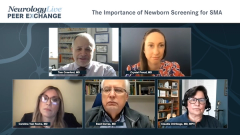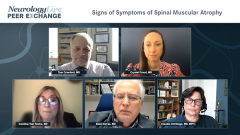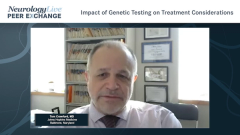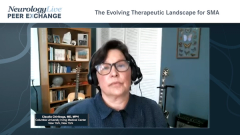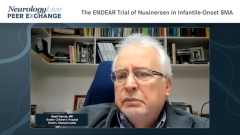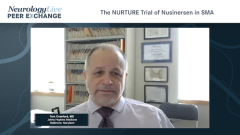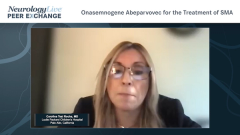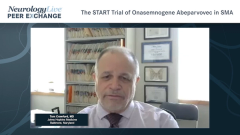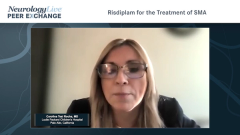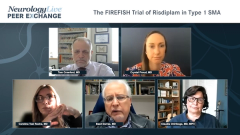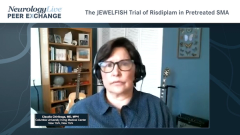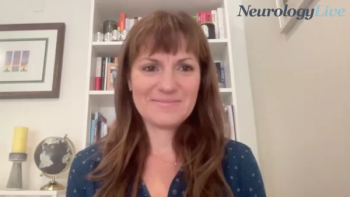
The NURTURE Trial of Nusinersen in SMA
Experts in neurology Tom Crawford, MD and Claudia Chiriboga, MD, MPH discuss the impact of the NURTURE trial of nusinersen in patients with presymptomatic SMA.
Episodes in this series

Crystal Proud, MD: That was a great review of the impact on symptomatic patients. As you mentioned, it was examined in presymptomatic, genetically confirmed babies with spinal muscular atrophy [SMA]. Tom, perhaps you could walk us through the importance of the NURTURE trial and the conversation that it sparked when those results were made available.
Thomas Crawford, MD: Sure thing. The NURTURE trial was a groundbreaking trial because it was a trial of 25 presymptomatic babies in the era before newborn screening. They had to go around the world, setting up 30 different sites to come up with these kids that were not common beforehand; they showed a dramatic age-related response. The earlier these patients are treated, the better off they are. We also learned other things from the trial. The kids with 3 copies were treated early on and tracked normal motor milestones according to the WHO [World Health Organization] criteria. The kids who had 2 copies really did better, because they completed it better, but the gap started to open up the further along they went. It raises some really interesting questions about natural history. If you are seeing an increase in the gap between normal levels and those of patients who are being disease treated over time, does that mean the agent is losing its effectiveness over time?
Does that mean you are actually unveiling deficits that were there all along? Is it that babies do not have to have a full complement of motor neurons to be normal babies, but as they grow older—to the point that they’re starting to play soccer and run around—you can actually see deficits? Were they there all along, but you did not seen them? Or is it possible that there are other factors? I hinted at that: the developmental sequence. Are there other things that are fated to be unredeemable, that are lost over time? As a consequence of that? We have some big neuroscience questions to ask, and the NURTURE experience unveils it.
The other thing that was very cool about the ENDEAR trial but not the NURTURE trial is this biomarker that had been hinted about. We know that the neurofilament gene spilling into the blood and CSF [cerebrospinal fluid] is highest in the presymptomatic babies featured in the NURTURE trial. Before they were ever treated, they had the highest levels of all. Immediately after the onset of treatment, for the babies featured in the ENDEAR trial who were treated after the onset of symptoms, neurofilament levels will naturally decline with the disease as they lose motor neurons, but they will rapidly decline after the initiation of therapy. This tells us a lot about the presymptomatic disease that is going on.
The last thing: I was going to just add to what Basil [Darras] said. Though I’ve been doing this for 31 years, we just submitted my long-term dynamometer studies on strength and the measurements of all patients over a long period of time. The median follow-up for patients is 12 or 15 years; everybody declines. Everybody declines, whether they know it or not. One of the things that humans do is make excuses for why they are the same. “I cannot do that light switch because my shoulder hurts now, or because I was sick and I couldn’t get back to that.” The fact of the matter is that, within the range of ages—I’m a pediatric guy, so I do not treat lots of adults—the older these patients are, the fewer the members are. But within those groups, dynamometer measures a power decline as a function of time across all groups and all ages, so there is reason to treat.
Claudia Chiriboga, MD, MPH: I agree with you, Tom. There are just a few points I will add if I may. My interpretation of the divergence of the 2 and the 3 is that the 6-week cutoff that the NURTURE hand utilized is too late and that we need to treat our babies earlier, especially those with 2 SMN2 copies, because they do have that subclinical loss. Going back to Basil’s point, I have been very encouraged because I have been treating the CS3A arm of patients, which are the infants who were treated since 2012, and there is continuing improvement over time; it may be delayed.
Maybe they do not sit right away, but they will sit, and they continue to improve as long as they are being administered the medication. We are also accruing, on the other end, patients who do not fit the clinical trials’ criteria that do have improvement. I am just fighting with an insurance company that wants to take away nusinersen from a child who has type 1 but who, for 3 years, has been treated and has had an improvement on the CHOP-INTEND scale [Children’s Hospital of Philadelphia Infant Test of Neuromuscular Disorders] of 19 points. The patient has not had a respiratory infection and has had these other subclinical measurements that are outside the boundaries of our clinical trials that are beneficial and that continue to make progress. We do not measure that well, and that makes a big difference in the quality of life.
One point that Basil made about the adults who think they are stable and that they don’t come in—I agree with you that you do not want them to find out that they did lose function when they lose the ability to control their power wheelchair. Underscoring that, there is this subclinical loss that they do not want to have, and it is important to have them come back into the fold, to be treated now that we have 2 options for the older patients. That is worth the effort.
Thomas Crawford, MD: It is notable that the personal experience of decline is rated upon not any kind of measurable variable but experience. The motor things—the abilities that people use to scale their ability—they know what is right on the cusp of the things that they cannot do or things that they can just barely do. If you are declining very slowly, you might pass through a bunch of those milestones and say, “I had a really bad year because I lost a lot.” Then there may be a long period of it where there are really very few of those milestones experienced. Hence you say, “Well, I’m stable at this point,” when in fact, what is going on is that the metrics that we use are unequally distributed and hence there are “experiences of stability.” I completely agree with you. Folks with SMA are declining, always, very subtly. Then we have to consider the burden of benefits of therapy vs nontherapy treatment, knowing that that is the case.
Crystal Proud, MD: Reinforcing that is incredibly critical, especially in some of our 20-year-old patients who feel invincible, or that they’ll just put it off for a while. They may say, “I’m fine, Dr Proud. I’m the same as I’ve always been.” We have to be reinforcing the point that there is no such thing as stability in SMA while also maintaining that relationship and that trust and confidence that we are going to come to a conclusion together. It is an art. This is a discussion that we certainly will come back to, especially as we explore more options that are applicable to some of our older patients, apart from nusinersen.
Thank you for watching this Neurology Live® Peer Exchange. If you enjoyed the content, please subscribe to our e-newsletters to receive upcoming Peer Exchanges and other great content right in your in-box.
Transcript Edited for Clarity
Newsletter
Keep your finger on the pulse of neurology—subscribe to NeurologyLive for expert interviews, new data, and breakthrough treatment updates.

